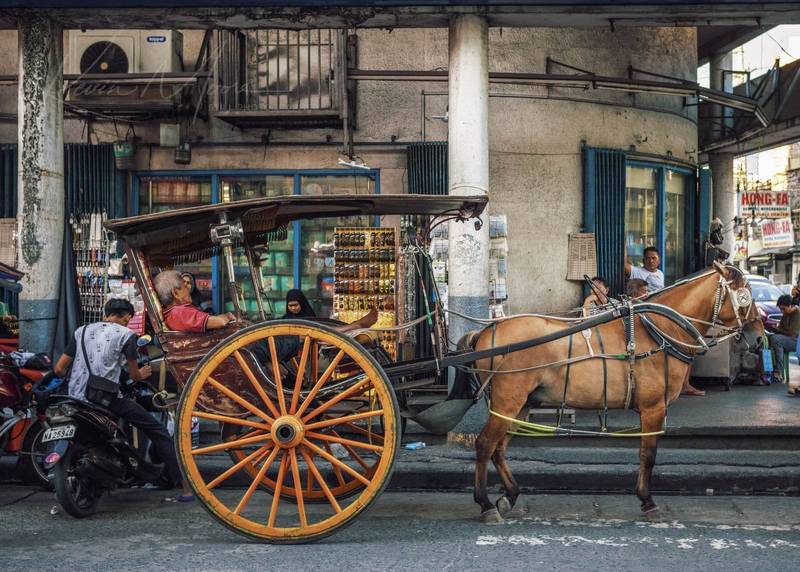
Philippines Urban Photography offers an extraordinary lens into the nation’s rich tapestry of contrasts, blending the historical with the contemporary. Among towering skyscrapers and bustling streets, unexpected moments of cultural nostalgia emerge, such as a horse-drawn carriage weaving through the heart of a modern cityscape. Armed with my Leica M11, I ventured into the vibrant streets of Manila and beyond, capturing scenes where tradition and modernity harmoniously intersect. Photographing a horse carriage in the Philippines transcends the act of taking a picture; it’s a journey through the layers of history, culture, and identity.
The Timeless Dance of Tradition and Modernity
Wandering through Philippine cities, one is struck by the seamless coexistence of past and present. Horse-drawn carriages, locally known as calesas, remain poignant symbols of this balance. In bustling metropolises like Manila, these carriages navigate alongside cars and jeepneys, providing a vivid visual representation of the nation’s dualities.
In the realm of Philippines Urban Photography, the calesas serve as cultural icons, linking today’s fast-paced lifestyle with a storied past. Each photograph of these enduring symbols encapsulates a narrative of resilience and continuity. When I captured a calesa against Manila’s urban backdrop with my Leica M11, the interplay of light and texture in the frame crystallized a moment where tradition and modernity coexist beautifully.
Leica M Rangefinder: A Photographer’s Essential for Urban Scenes
Urban photography demands tools that adapt to the dynamism of the streets, and the Leica M11 proved indispensable. Renowned for its intuitive design and unmatched optics, this camera allowed me to document intricate details like the rhythmic movement of the horse, the craftsmanship of the carriage, and the driver’s poised expression. The Leica M11’s ability to capture nuanced textures and light enhanced every shot, making each image a vivid story of its own.
Beyond its technical prowess, the camera’s dynamic range and responsiveness brought depth to fleeting moments. In one frame, the crunch of the calesa’s wheels on modern asphalt and the distant hum of city life merged into a single evocative image. For anyone pursuing Philippines Urban Photography, a reliable camera system like the Leica M11 ensures that no detail, emotion, or nuance is lost.
Echoes of History in Modern Streets
The enduring presence of calesas on Philippine streets harks back to the Spanish colonial era when these carriages were the epitome of transportation. Today, their presence in cities filled with high-rise buildings and buzzing traffic offers a unique juxtaposition. Photographing a calesa isn’t just about framing a subject; it’s about capturing a living fragment of history.
As a photographer, I found these moments deeply reflective. They reminded me that urban spaces are more than just physical environments—they are repositories of memory and identity. Each horse-drawn carriage seen through the lens serves as a gentle reminder of the Philippines’ layered heritage and its efforts to preserve tradition in a rapidly modernizing world.
Storytelling Through Street Photography
In the context of Philippines Urban Photography, every image is a narrative. Capturing a calesa in motion—its wheels turning against the backdrop of a neon-lit city street—illustrates the coexistence of eras. Such photographs act as corridors into the past while highlighting how tradition adapts to the present.
For photographers, street photography goes beyond visual appeal. It involves weaving together fragments of culture, history, and emotion into a cohesive story. The calesa, with its symbolic weight, provides an ideal subject to fulfill this dual responsibility. Each frame becomes a canvas for documenting the resilience and evolution of Filipino culture.
Why Horse Carriages Endure in Philippine Cities
Despite the advent of modern technology, horse-drawn carriages continue to thrive, serving as cultural ambassadors in urban settings. Their appeal lies not just in their nostalgic charm but also in their role as reminders of a time when life moved at a slower pace. For travelers, encountering a calesa offers a window into the Philippines’ colonial past while highlighting its post-independence growth.
These carriages symbolize the delicate balance between honoring history and embracing progress. Their continued presence on city streets is a testament to the nation’s ability to integrate tradition thoughtfully into modern life. For photographers, this dynamic creates endless opportunities for compelling storytelling.
Custom Prints Available Upon Request
If you’re inspired by the imagery of Philippines Urban Photography or wish to own a custom print of the featured horse carriage photographs, we offer personalized prints on request. These prints make for stunning additions to any space, showcasing the timeless beauty of Filipino heritage. Visit our contact form to inquire about custom prints or explore other captivating images from the collection.
Conclusion: Capturing Continuity Through the Lens
Few subjects embody the spirit of Philippines Urban Photography like a horse carriage traversing a modern city street. These scenes underscore the nation’s cultural continuity, offering a poignant reminder that tradition and progress can coexist harmoniously.
Photographing a calesa is about more than just creating a visually striking image. It’s an invitation to explore the layers of history and culture that define the Philippines. With the Leica M11, every gallop and turn of the wheel becomes a cinematic moment, immortalizing the fragile beauty of old and new.
Whether you’re a seasoned photographer or a traveler eager to capture the soul of the Philippines, let the enduring image of the calesa inspire you. In this multifaceted archipelago, history continues to ride alongside the present, always just a shutter click away.
